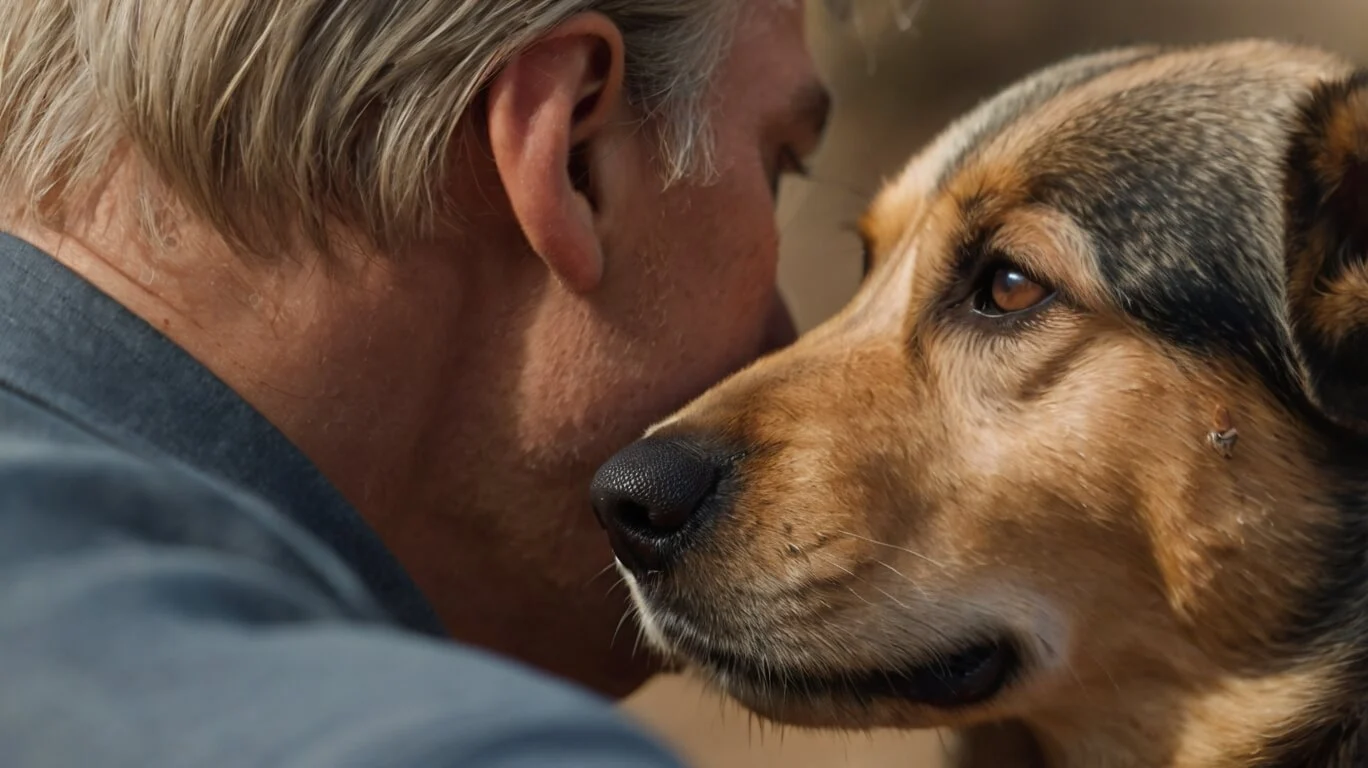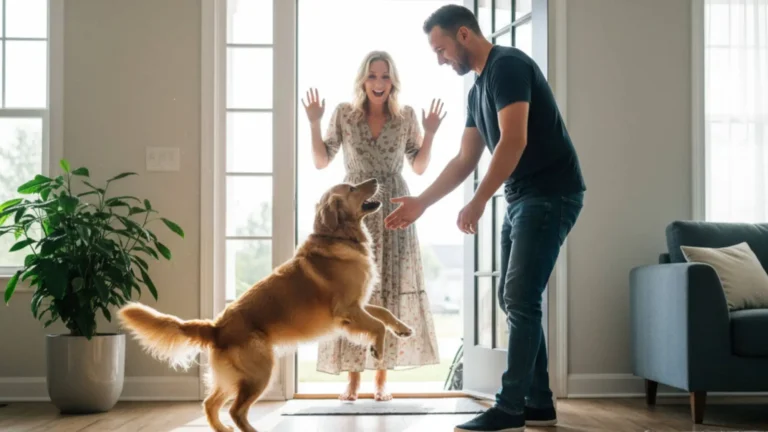What Is the Most Common Command Taught to Dogs? (And Why It Matters)
Training your dog isn’t just about teaching cute tricks—it’s about building communication, trust, and structure. Whether you’ve just brought home a playful puppy or you’re working with an older rescue, one question always pops up: What is the most common command taught to dogs? The answer is simple—“sit.”The “sit” command is often the very first lesson in basic obedience training, and for good reason. It’s easy to teach, quick to learn, and lays the groundwork for more advanced commands like “stay,” “come,” and “leave it.” But beyond its simplicity, teaching your dog to sit can make a big difference in their behavior, safety, and how well they respond to you in everyday life.In this post, we’ll explore why “sit” is the most commonly taught dog command, how to teach it effectively, and other essential commands that every pet owner should know. Let’s jump in!
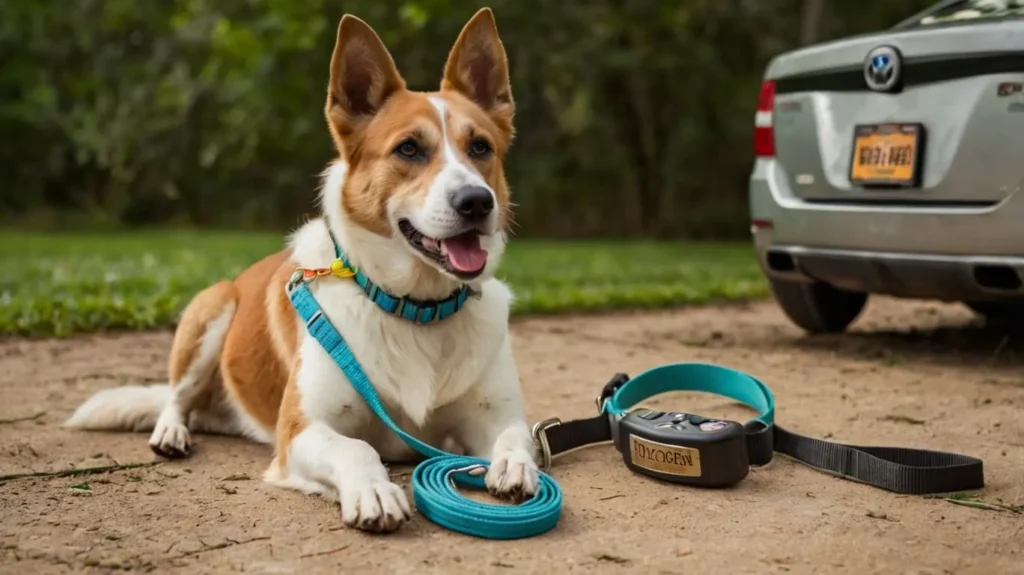
Why Teaching Basic Commands Is Crucial for Your Dog
Promotes Safety
Teaching your dog basic commands—especially the “sit” command—is one of the most effective ways to ensure their safety in everyday situations. It might seem simple, but having your dog respond instantly to “sit” can prevent accidents, injuries, and even life-threatening scenarios.
Imagine walking near a busy road, and your dog suddenly gets excited by a squirrel or another dog. If they haven’t learned to obey the “sit” command, they might lunge forward, putting themselves—and potentially others—at risk. With a solid “sit” foundation, you can stop them in their tracks, giving you full control in potentially dangerous moments.
This command also comes in handy during:
- Vet visits: Helping your dog stay calm in unfamiliar or stressful environments.
- Crossing streets or parking lots: Teaching them to wait before moving forward.
- Meeting strangers or children: Prevents jumping, which can startle people or cause injury.
Many professional trainers and organizations, including the American Kennel Club (AKC), emphasize safety as one of the primary reasons to start with basic obedience training. A well-trained dog is not only more obedient but also far less likely to end up in a dangerous situation due to impulsive behavior.
So while “sit” might seem like a minor command, its role in protecting your pup—and making your life easier—cannot be overstated.
Builds Communication
One of the most rewarding aspects of training your dog is the connection it creates between you and your furry companion. Teaching basic commands like “sit” isn’t just about obedience—it’s the beginning of a two-way conversation that strengthens your bond and builds mutual understanding.
Dogs thrive on structure and clear signals. When you consistently use a command like “sit,” followed by a reward or positive reinforcement, your dog begins to understand your expectations. This process forms the basis of communication. Over time, your dog learns to listen, respond, and even anticipate what you want in different situations.
Effective communication leads to:
- Better behavior at home and in public: Your dog knows how to act in various environments.
- Stronger trust: When dogs understand what’s being asked of them, they feel more confident and secure.
- Easier socialization: Clear commands help guide interactions with other dogs and people.
As training continues, commands become more than instructions—they become cues for your dog to engage with you. Whether it’s “sit,” “stay,” or “come,” every command builds on the communication foundation started with that very first lesson.
And it’s not just about the words you say—your tone, body language, and consistency all contribute to effective dog communication. Starting with “sit” is the easiest and most natural way to begin this lifelong dialogue.
Reduces Behavioral Issues
Unwanted behaviors like jumping on guests, excessive barking, chewing furniture, or pulling on the leash often stem from a lack of structure and mental stimulation. Teaching your dog basic commands—starting with “sit”—helps curb these behaviors by giving them clear guidance and a sense of purpose.
Dogs are eager to please and naturally look for leadership. When they don’t receive consistent direction, they may act out of boredom, anxiety, or confusion. Obedience training creates boundaries, establishes routines, and provides mental engagement, all of which are key to preventing behavioral issues.
Here’s how teaching commands like “sit” helps:
- Redirects What Is the Most Common Dog Command and Why Is It “Sit”?energy: Instead of jumping or barking, dogs learn to focus on following commands.
- Encourages impulse control: “Sit” teaches your dog to pause and think before acting.
- Builds patience: Waiting for cues and rewards helps your dog develop calm behavior.
For example, a dog that automatically sits when greeting someone is far less likely to jump up. A dog trained to “sit” before being fed or going outside learns patience and respect for boundaries—two traits that influence overall behavior at home and in public.
Many professional trainers, including those at the AKC Canine Good Citizen Program, highlight that early training leads to more manageable adult dogs. The simple act of teaching “sit” can be your first step toward preventing long-term behavioral problems—and creating a well-balanced, happy pup.
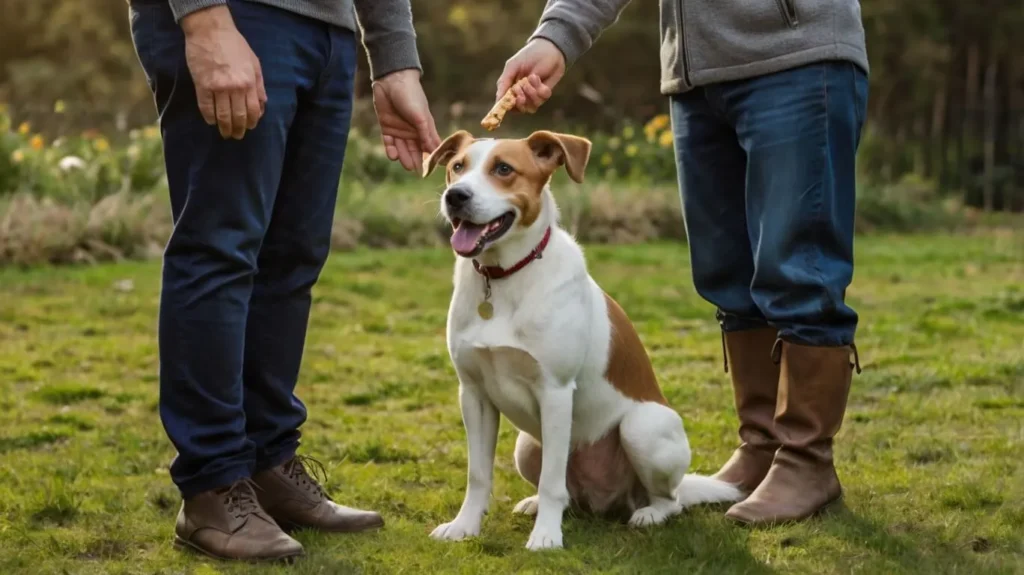
What Is the Most Common Dog Command and Why Is It “Sit”?
Simplicity
One of the main reasons “sit” is the most common command taught to dogs is because of its simplicity—both for the dog to understand and for the owner to teach. It doesn’t require advanced training techniques, special equipment, or a lot of space. In fact, most dogs can begin learning “sit” within minutes, even as early as 8 weeks old.
This command has a clear physical motion that naturally follows a dog’s instincts. When a dog looks up at something—especially if you’re holding a treat—they often lower their back end, which makes teaching the command easier and more intuitive.
Here’s why “sit” is such a simple and effective starting point:
- Minimal training experience required: Even first-time dog owners can teach it successfully.
- Quick wins: Dogs typically pick it up faster than more complex commands, helping build confidence in both the pet and the trainer.
- Foundation for other behaviors: “Sit” lays the groundwork for future obedience training like “stay,” “down,” and “wait.”
The beauty of “sit” lies in how universally applicable and repeatable it is. Whether you’re at home, in the park, or visiting the vet, it’s a command that helps you regain control quickly and easily. Because of its straightforward nature, “sit” becomes a reliable tool that supports positive behavior and sets the stage for more advanced training in the future.
So, while it may seem basic, the simplicity of “sit” is exactly what makes it so powerful—it’s often the first building block in a well-trained dog’s education.
Foundation Command
“Sit” isn’t just a basic cue—it’s a foundation command that sets the tone for your dog’s entire training journey. Once your dog reliably understands and responds to “sit,” it becomes significantly easier to introduce more complex commands and behaviors. Think of it as the first brick in the structure of a well-behaved dog.
When your dog learns to sit on command, they also start learning how to learn—they begin to understand the pattern of listening, responding, and being rewarded. This process builds trust, focus, and a willingness to engage with you, which are essential elements of long-term obedience training.
Here’s why “sit” is considered the foundation of dog training:
- Teaches attention and response: “Sit” helps dogs develop the habit of tuning in to your voice and body language.
- Used as a starting point for other commands: Commands like “stay,” “wait,” and “down” often begin from a sitting position.
- Helps manage excitement and impulse control: Asking your dog to sit before meals, walks, or greeting people encourages calm, controlled behavior.
Professional trainers and behaviorists often refer to “sit” as the gateway command—a cue that signals structure and signals to the dog that it’s time to focus. Even in high-distraction environments, dogs who master this foundational skill are more likely to remain under control and responsive.
By starting with “sit,” you’re not just teaching a trick—you’re building a training system. It’s the base upon which a well-behaved, confident, and obedient dog is built.
Widely Recommended
When it comes to dog training, the “sit” command is not just a recommendation—it’s widely endorsed by professional trainers, animal behaviorists, and reputable organizations like the American Kennel Club (AKC). Across the board, “sit” is regarded as an essential first command that provides immediate benefits and sets the stage for further training.
The simplicity and effectiveness of “sit” make it a universally recommended starting point for any dog training program. Here’s why so many experts champion it:
- Easy for dogs to grasp: Most dogs can master the “sit” command within a few training sessions, even without prior experience.
- Universal application: Whether you’re a seasoned trainer or a new dog owner, “sit” is useful in nearly any situation, from preventing jumping on guests to calming your dog during high-energy moments.
- Foundation for advanced training: Once your dog has mastered the basics of “sit,” it becomes much easier to introduce more complex commands like “stay,” “heel,” or “roll over.” It’s an essential stepping stone in the progression of dog training.
Trainers like Cesar Millan and organizations like the AKC consistently emphasize that “sit” isn’t just the first trick—it’s a command that improves the quality of life for both the dog and owner. By focusing on “sit,” you’re creating a framework for all future obedience training.
Moreover, the widespread use and recommendation of this command make it a social norm in the dog training world. It’s so simple that it’s often the first trick taught in obedience schools, puppy classes, and even in online training courses. It’s an essential building block in establishing trust and respect between you and your dog, which leads to a harmonious relationship.
In short, “sit” is widely recommended because it works—it’s easy to teach, and it helps set the groundwork for a lifetime of successful training and bonding.
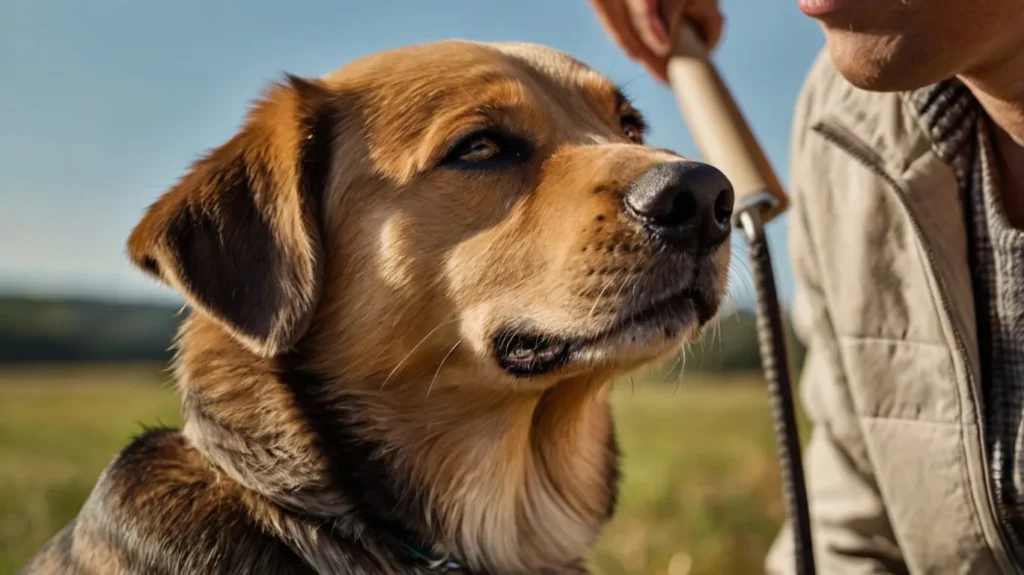
How to Teach the “Sit” Command: Step-by-Step Guide
Step 1: Use Treats and Say the Word “Sit” Clearly
The first step in teaching your dog the “sit” command is to grab their attention and create a positive association with the action. Using treats effectively and clearly saying the word “sit” helps your dog understand exactly what is expected and rewards them for a job well done. This step is all about clarity, patience, and positive reinforcement.
Here’s a breakdown of how to make this first step as effective as possible:
1. Use High-Value Treats
Choose a treat that your dog really loves. While your dog may respond to everyday kibble, it’s important to use high-value treats—something they don’t get all the time, like small pieces of chicken, cheese, or a special dog treat. This makes the training session exciting and motivates your dog to focus on you and the task at hand.
2. Get Your Dog’s Attention
Before issuing the command, ensure your dog’s full attention is on you. This is key to effective communication. Hold the treat near their nose so they can smell it, but don’t let them take it just yet! Your dog should be focused on the treat and watching you closely, ready to follow your lead.
3. Give the Command “Sit” Clearly
Once you have your dog’s attention, say the word “sit” in a clear, calm, and consistent tone. Dogs respond best to commands when they are short, simple, and said in a firm but friendly voice. Avoid using long phrases or a high-pitched voice, as this can confuse your dog.
Keep your tone consistent, whether you’re training your dog in the living room or at the park. This consistency will help your dog link the word “sit” with the desired action over time.
4. Lure Your Dog Into the Sitting Position
Gently move the treat in front of your dog’s nose and slowly raise it upward, just over their head. This will encourage your dog to lower their rear end to the ground as they follow the treat with their eyes. At this point, their natural instinct is to sit down in order to stay focused on the treat.
Be patient and allow the dog to sit naturally as you move the treat. If your dog doesn’t immediately sit, try gently guiding their bottom down with your hand (without forcing them) to help them understand the motion.
5. Reward Immediately
As soon as your dog’s bottom touches the ground, immediately praise them with a cheerful “Good sit!” and offer the treat. Timing is crucial—your dog needs to connect the action of sitting with the reward. This positive reinforcement helps them understand that sitting is the desired behavior.
By using treats as a reward, you’re establishing a positive association with the action, reinforcing the behavior every time they do it correctly.
In this first step, you’re setting up a successful foundation for teaching “sit” and ensuring your dog understands the reward system. This clear, structured approach helps them grasp the command quickly, building the momentum for further training.
Step 2: Guide the Dog’s Movement Gently and Reward Instantly
At this stage of training, your dog may not fully understand the “sit” command on their own yet, which is perfectly normal. Guiding their movement gently helps them make the connection between the treat, the word “sit,” and the action of sitting. The key here is to make the learning process as clear and easy as possible for your dog.
Here’s how to guide your dog effectively and reward them right away:
1. Gently Guide Their Rear End Into the Sitting Position
As you use the treat to lure your dog into the sitting position, they may need some assistance to fully understand what you want. This is where you can gently guide them by placing your hand on their back or near their rear end. Do not force them down—instead, encourage them by applying light pressure to help them sit.
Move the treat above their nose and slightly toward their tail. This will often cause their back end to naturally lower to the ground. If they’re hesitant or confused, lightly guide their bottom into a sitting position with your hand. Be patient, and never pull or push too hard—this should be a gentle nudge.
2. Be Patient and Let Them Figure It Out
Training takes time, and every dog learns at their own pace. If your dog doesn’t immediately sit, don’t rush or show frustration. Let them explore and figure out the movement on their own. Once they begin to associate sitting with the treat and your “sit” command, it will become a more natural response.
You may need to repeat the process a few times before your dog gets it right. This is part of building muscle memory. Just ensure that every time they make progress, even a small one, they are rewarded!
3. Reward Instantly When They Sit
Once your dog successfully sits, immediately reward them with praise and a treat. Timing is everything in dog training—if you wait too long to give the treat or praise, your dog might not make the connection between the sitting action and the reward. As soon as their bottom touches the ground, praise them with an enthusiastic “Good sit!” or “Yes!” followed by the treat.
By rewarding them instantly, you are reinforcing the behavior they just performed and showing them that sitting is the correct response. Positive reinforcement at this stage is vital to strengthen their understanding of the command.
4. Use Consistent Praise and Treats
It’s important to use consistent praise every time they sit, along with the treat. In the beginning, dogs often need frequent rewards to stay motivated and reinforce the new behavior. As they progress and become more confident in their ability to sit, you can gradually reduce the frequency of treats, offering rewards intermittently. However, always continue praising them verbally to maintain the positive reinforcement.
5. Repeat and Build Confidence
Repetition is key in any dog training, especially during the early stages. After they successfully perform the “sit” command, repeat it several times in short, consistent training sessions (5-10 minutes). This helps to build your dog’s confidence and reinforces the new behavior in their mind.
By guiding them gently and rewarding them instantly, you create a positive, structured environment that supports learning and fosters trust between you and your dog. Over time, as your dog becomes more comfortable with the “sit” command, they’ll begin to respond without the need for as much guidance.
This step is all about creating a connection between the command, the physical action, and the reward. The key is to make the experience positive, clear, and repetitive, allowing your dog to grasp the behavior more quickly.
Step 3: Repeat and Gradually Phase Out Treats
Repetition and consistency are key in dog training, especially when it comes to reinforcing a behavior like “sit.” However, as your dog becomes more reliable in responding to the command, it’s important to start phasing out treats gradually. This step helps your dog understand that they should listen to the command regardless of whether they receive a treat every time, creating long-term obedience that doesn’t rely solely on food rewards.
Here’s how to effectively phase out treats while maintaining good behavior:
1. Repetition is Key to Solidifying the Command
In the early stages of training, your dog will need lots of repetition to learn and remember the “sit” command. You should practice the “sit” command several times throughout the day, in various environments, to help them generalize the behavior. Short, consistent sessions (5-10 minutes) will help reinforce the command without overwhelming your dog.
By repeating the behavior and providing positive reinforcement, you’re helping your dog commit the action to memory, making it a habit they can perform even in new or distracting situations. You’ll notice that your dog starts to understand what “sit” means and may begin to respond faster and more confidently.
2. Start Phasing Out Treats Gradually
Once your dog reliably responds to the “sit” command, you can begin to reduce the frequency of treats as a reward. The goal is to move from a constant reward system (treats after every sit) to an intermittent one. This is where the concept of “variable reinforcement” comes into play—giving a treat randomly instead of every time they perform the behavior.
To start phasing out treats:
- Give a treat every other time your dog sits, then gradually move to every third time, and so on.
- Offer praise as the primary reward: Continue verbal praise like “Good sit!” or “Yes!” along with a pet or a belly rub. This shows your dog that they’re still doing something right, even if a treat isn’t given every time.
- Introduce other rewards: If your dog enjoys toys or affection, mix in these non-food rewards to reinforce the command. For example, after they sit, you can throw their favorite toy or give them a few minutes of playtime. This keeps the training session exciting without relying solely on food.
3. Reinforce with Treats in Distractions
While you’re phasing out treats, it’s still important to offer them periodically—especially in more challenging or distracting environments. For instance, if you’re practicing the “sit” command in a noisy park, at the vet, or around other dogs, you may want to give a treat more often. The goal is to ensure your dog stays motivated and understands that “sit” is a command they should follow in any situation.
4. Keep the Sessions Fun and Short
As you reduce the use of treats, it’s crucial to keep training sessions engaging and fun. Don’t make it all about rewards. Dogs thrive on interaction and attention from their owners. Use a playful voice, give plenty of praise, and mix up the rewards so your dog stays interested in the training process.
Make sure training doesn’t feel like a chore. Keep the sessions positive, and gradually introduce more advanced commands as your dog becomes more consistent with “sit.” This keeps your dog mentally stimulated and eager to learn more.
5. Transition to a Balanced Reward System
Eventually, your dog will respond to the “sit” command with little to no need for treats. At this point, you’re aiming for a balanced reward system where treats are occasionally used as a special reward rather than a daily necessity. It’s important to recognize that even without treats, positive reinforcement (like praise, affection, or playtime) is still key to maintaining a well-behaved dog.
Gradually, your dog will begin to sit on command not because they expect a treat every time, but because they understand that it’s the right behavior. The treats will simply become a fun, occasional bonus that adds to their motivation.
Phasing out treats doesn’t mean eliminating rewards entirely—it means moving towards a more balanced and sustainable training approach. As your dog becomes more proficient with the “sit” command, you’re creating a lasting habit that doesn’t rely on food but on consistent, clear communication and positive reinforcement.
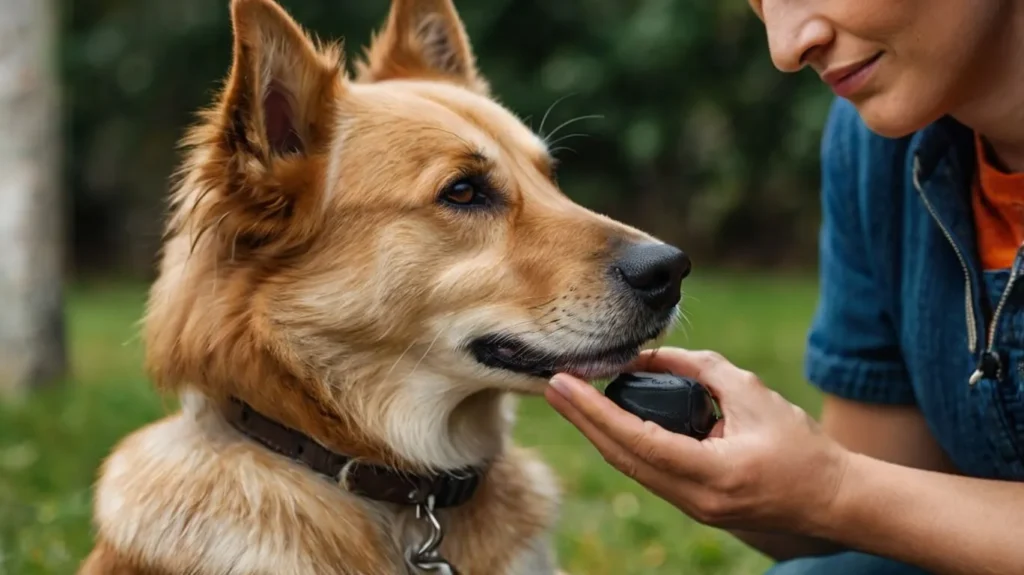
Other Essential Dog Commands Every Owner Should Know
Stay: Keeps Your Dog in Place for Safety
The “stay” command is an essential part of a dog’s training that directly contributes to their safety, as well as the safety of those around them. Once your dog has learned the basic “sit” command, teaching them to “stay” is a natural next step that allows you to maintain control in various situations. “Stay” helps ensure that your dog doesn’t rush off into dangerous areas, run into traffic, or become distracted when you need them to be calm and stationary.
Here’s why the “stay” command is crucial for safety and how it plays a role in everyday situations:
1. Prevents Hazardous Situations
One of the most obvious safety benefits of teaching your dog to stay is that it keeps them from running off or into potentially harmful situations. Whether you’re crossing the street, getting in and out of your car, or walking near busy areas, the “stay” command ensures that your dog remains in a secure position while you navigate the environment. For example, when you need to open the front door, having your dog stay in place prevents them from darting outside and into traffic or a dangerous situation.
Additionally, if your dog is ever off-leash in a public area or park, the “stay” command can keep them in a safe spot while you manage your surroundings or handle an emergency. It reduces the likelihood of your dog making sudden, unsafe decisions.
2. Provides Control in High-Distraction Situations
In busy environments with distractions—such as crowded parks, busy streets, or even during veterinary visits—“stay” is a powerful tool to ensure your dog stays calm and focused on you. Dogs can easily become overstimulated by loud noises, other dogs, or unfamiliar people, but by using the “stay” command, you give your dog a clear expectation of behavior.
For instance, when walking in a crowded area, asking your dog to stay while you navigate the crowd keeps them from getting overly excited or pulling on the leash. It ensures they stay close to you and don’t inadvertently get lost or cause a disruption.
3. Promotes Impulse Control and Calmness
The “stay” command is also excellent for teaching your dog impulse control. When a dog is asked to stay, they must wait for your permission before moving, which teaches them to resist the urge to chase after distractions, such as squirrels, cars, or other dogs. Over time, this helps create a more composed, well-mannered dog who can control their impulses and respond calmly in various situations.
For example, if you’re at the beach or in a situation where your dog is excited to run around, asking them to stay for a few moments gives them the chance to settle and control their excitement before releasing them to enjoy the activity safely. This type of controlled freedom fosters a sense of security for both the dog and the owner.
4. Essential for Grooming, Veterinary Visits, and Training
The “stay” command is incredibly useful when it comes to grooming and health care routines. Whether you’re brushing your dog, trimming their nails, or taking them to the vet, asking them to stay in one spot allows you to complete these tasks without resistance. It keeps your dog calm and cooperative, reducing stress for both you and your dog.
At the vet, for example, asking your dog to stay during an examination can make it much easier for the vet to assess their health without worrying about your dog squirming or trying to escape. This is particularly important for dogs that may have a tendency to be anxious during such visits.
5. Builds Trust Between You and Your Dog
Teaching your dog to stay fosters trust and respect in your relationship. They learn that you’re asking them to stay in place not as a form of punishment, but as a way to ensure their safety and well-being. It creates a deeper understanding that you are guiding them through the world in a way that keeps them protected.
By consistently practicing “stay” in various situations, your dog will begin to look to you for guidance, knowing that when you ask them to stay, it’s for their safety and that something positive (like a walk or a playtime session) will follow.
In conclusion, teaching your dog to stay is not just about obedience—it’s a critical safety tool that helps you maintain control in potentially risky situations. Whether you’re keeping your dog in one place while you cross the street, managing distractions in public places, or creating a calm and composed pet at the vet, “stay” is an invaluable command that ensures both the safety and well-being of your dog.
Come: Ensures Your Dog Returns on Cue
The “come” command is one of the most essential and life-saving cues you can teach your dog. It guarantees that when called, your dog will return to you, regardless of the situation. Whether you’re in a park, near a busy road, or in a potentially dangerous environment, a reliable “come” command can keep your dog safe and prevent them from running off or getting into harm’s way.
Here’s why the “come” command is so important and how to effectively teach it:
1. Vital for Safety and Control
The primary benefit of teaching your dog the “come” command is safety. Dogs are naturally curious and may get distracted by something exciting, like a squirrel, another dog, or an interesting smell. If they are off-leash in an open space or during outdoor activities, there’s always the risk they might wander off or get into dangerous situations. By teaching them to come when called, you have control over their movements and can ensure they stay close to you in situations where they might otherwise run off.
For example, when walking your dog off-leash at the park or beach, calling them back to you at the first sign of danger—such as an approaching car or other dogs—ensures that they are out of harm’s way and by your side where you can keep them safe.
2. Builds a Stronger Bond
Teaching the “come” command is not just about control—it’s also about strengthening the bond between you and your dog. The more you practice “come,” the more your dog learns that responding to you is rewarding, and that you’re guiding them to positive experiences. This reinforces your role as a leader and builds trust, as your dog learns they can rely on you for direction and safety.
Using positive reinforcement when your dog responds to “come” builds a connection based on mutual understanding. Your dog will associate coming to you with rewards, affection, and good experiences, making them more eager to listen when you call them.
3. Essential for Emergency Situations
In emergency situations, the “come” command could be the difference between life and death. For example, if your dog starts running towards traffic or a dangerous animal, you need them to return to you immediately. The more reliable your dog’s recall (their response to “come”), the quicker they’ll stop what they’re doing and head back to you, even in moments of high excitement or distraction.
In these high-stress situations, timing is everything. The “come” command helps you gain quick control and prevent dangerous situations, whether your dog is off-leash, running in an open area, or distracted by something like a bird or another dog.
4. Effective in Various Environments
The “come” command should be practiced in a variety of environments to help your dog generalize the behavior. This means training them to come to you whether they are in the comfort of their home or at a park with plenty of distractions. The more your dog associates the command with a positive outcome, regardless of their location, the more reliable their recall will be.
To make your dog’s response to “come” more consistent:
- Practice in different places: Start in a quiet room, then move to the backyard, then try a park with other dogs or people around.
- Gradually increase distractions: When you practice “come,” have your dog in different situations—like near other dogs or in a public space with cars and other distractions. This helps them learn to respond to your command even in chaotic environments.
5. Make the Command Fun and Rewarding
As with all training, the “come” command should be fun for your dog. Use high-value treats, toys, or affection to make returning to you an exciting and rewarding experience. You can even play games with your dog, such as hide-and-seek or fetch, that involve the “come” command. The more fun and engaging the process is, the more likely your dog will enjoy responding to the cue.
It’s also essential to never punish your dog when they come to you. If your dog does something wrong (like running off), avoid scolding them when they return. This could create a negative association with the “come” command. Instead, always reward your dog when they come back, regardless of the situation, to reinforce the idea that coming to you is always a positive action.
In summary, teaching your dog to “come” is more than just a command—it’s a critical safety measure that ensures your dog’s well-being in potentially dangerous situations. By practicing it consistently and reinforcing positive experiences, you not only keep your dog safe but also strengthen the trust and bond between you and your furry friend.
Leave It: Prevents Ingestion of Dangerous Objects
The “leave it” command is one of the most critical cues you can teach your dog, particularly for their safety. Dogs, especially puppies, tend to explore the world with their mouths. They are often curious and may attempt to ingest items they find—some of which can be hazardous, such as food wrappers, toxic plants, or sharp objects. The “leave it” command gives you control over these potentially dangerous situations, preventing your dog from eating or interacting with harmful substances.
Here’s why “leave it” is essential for your dog’s safety and how to effectively teach it:
1. Prevents Harmful Ingestion
Dogs are notorious for picking up anything that smells interesting or appears edible. Unfortunately, not everything they find is safe. Whether it’s a discarded piece of food, a dangerous plant, or even something non-food-related like a plastic toy or a foreign object, ingestion of harmful substances can lead to poisoning, choking, or internal injury.
By teaching your dog to “leave it,” you can stop them before they put something dangerous in their mouths. This is particularly important during walks, hikes, or outings, where they may encounter potentially toxic foods (like chocolate, grapes, or xylitol), trash, or sharp objects that could lead to injury. The ability to quickly stop your dog from touching or eating something harmful can save you from expensive vet visits or worse.
2. Keeps Your Dog Safe from Harmful Substances
There are numerous situations where a “leave it” command can be a lifesaver. For example, if you’re walking your dog through a neighborhood and they try to eat something that has been thrown away or discarded, a quick “leave it” can stop them in their tracks. The same applies to situations where your dog might be tempted to chew on dangerous household items, like electrical cords, toxic plants, or cleaning supplies.
In these cases, the “leave it” command acts as an early intervention to prevent your dog from coming into contact with something that could harm them. Over time, your dog will learn that the command means to stop whatever they are doing immediately, making them less likely to engage with risky objects in the future.
3. Promotes Good Manners Around Food
The “leave it” command is also essential in preventing undesirable behaviors, like counter surfing or stealing food. Many dogs have a natural instinct to grab food if it’s left unattended, whether it’s on the kitchen counter or in your hand. Teaching “leave it” helps curb these behaviors and teaches your dog to respect boundaries around food.
For instance, if you’re preparing a meal or have food sitting on the table, a well-trained dog will understand that they should not take food without permission. This establishes trust and discipline around food, which is essential for good behavior in the home.
4. Reduces Risk of Self-Harm or Injury
It’s not just food that can be dangerous for dogs. There are many non-edible objects that your dog may try to eat or chew on that could lead to serious injury. Sharp objects, such as broken glass, metal, or plastic, can puncture your dog’s mouth or digestive tract. Similarly, small objects like batteries or rubber bands can cause choking or obstruction.
By teaching your dog the “leave it” command, you’re reducing the risk of these types of injuries. It ensures that your dog doesn’t chew on objects that could harm them, whether they are toys, household items, or items they encounter outside.
5. Helps Maintain Control in Unpredictable Environments
“Leave it” is particularly useful in environments where there are multiple distractions, such as parks, beaches, or crowded areas. Dogs may encounter food or other enticing objects that they would normally try to ingest. In these situations, having a strong “leave it” command gives you control and ensures your dog stays safe.
For example, if you’re at a dog park and another dog drops a toy or piece of food that could be harmful, telling your dog to “leave it” ensures they don’t pick it up, avoiding a potentially dangerous situation. Similarly, in a city setting, where you might encounter dropped food or trash on the street, the “leave it” command prevents your dog from scavenging.
6. Encourages Positive Interaction with the Environment
Teaching your dog to “leave it” doesn’t just stop them from engaging with dangerous or unwanted objects—it also teaches them to focus on positive interactions with the world around them. When a dog successfully listens to the command, they learn to redirect their attention to something more appropriate, like you, a toy, or a different part of the environment.
By using positive reinforcement—such as treats, praise, or toys—you’re rewarding your dog for choosing safe behaviors, which strengthens their understanding of the command and their ability to remain focused on you, rather than on potentially harmful distractions.
In conclusion, the “leave it” command is an invaluable tool for protecting your dog from ingesting dangerous substances, harmful objects, or engaging in risky behaviors. It helps keep your dog safe in a wide variety of environments, prevents unwanted behaviors like counter surfing, and promotes positive habits and focus. By consistently practicing and reinforcing this command, you’re not only safeguarding your dog’s well-being but also creating a more controlled, respectful, and safe environment for them to navigate.
Conclusion: The Importance of Basic Commands in Dog Training
In summary, basic commands like “sit,” “stay,” “come,” and “leave it” are not just obedience cues—they are essential tools for safeguarding your dog and strengthening your bond with them. These foundational commands help ensure that your dog remains safe in a variety of situations, whether they’re out in public, at home, or encountering potential hazards. They also foster a sense of trust and communication between you and your dog, creating a relationship built on mutual respect and understanding.
Teaching your dog these commands early on provides many long-term benefits, including:
- Enhanced safety: Commands like “stay” and “leave it” can prevent dangerous situations, such as running into traffic or ingesting harmful objects.
- Improved communication: With consistent training, your dog learns how to interpret your cues, leading to a more harmonious relationship.
- Behavioral control: These basic commands reduce unwanted behaviors, such as counter surfing or impulsive running, by establishing clear boundaries and expectations.
As with any training, patience, repetition, and positive reinforcement are key to success. Reinforce behaviors consistently and reward your dog with treats, praise, or playtime to keep the training process fun and engaging. Remember, the goal is not only to teach your dog specific behaviors but to build a stronger bond and ensure they’re well-prepared for life’s challenges.
By incorporating these commands into your dog’s training routine, you’re laying the groundwork for a well-behaved, safe, and confident dog. With time and consistency, your dog will be able to navigate various environments with confidence, knowing exactly how to respond when needed.
So, whether you’re just starting to train your dog or you’re reinforcing established commands, remember that every successful training session brings you one step closer to a well-mannered and safer companion. Start practicing today and see how these basic commands can make a world of difference for both you and your dog!

